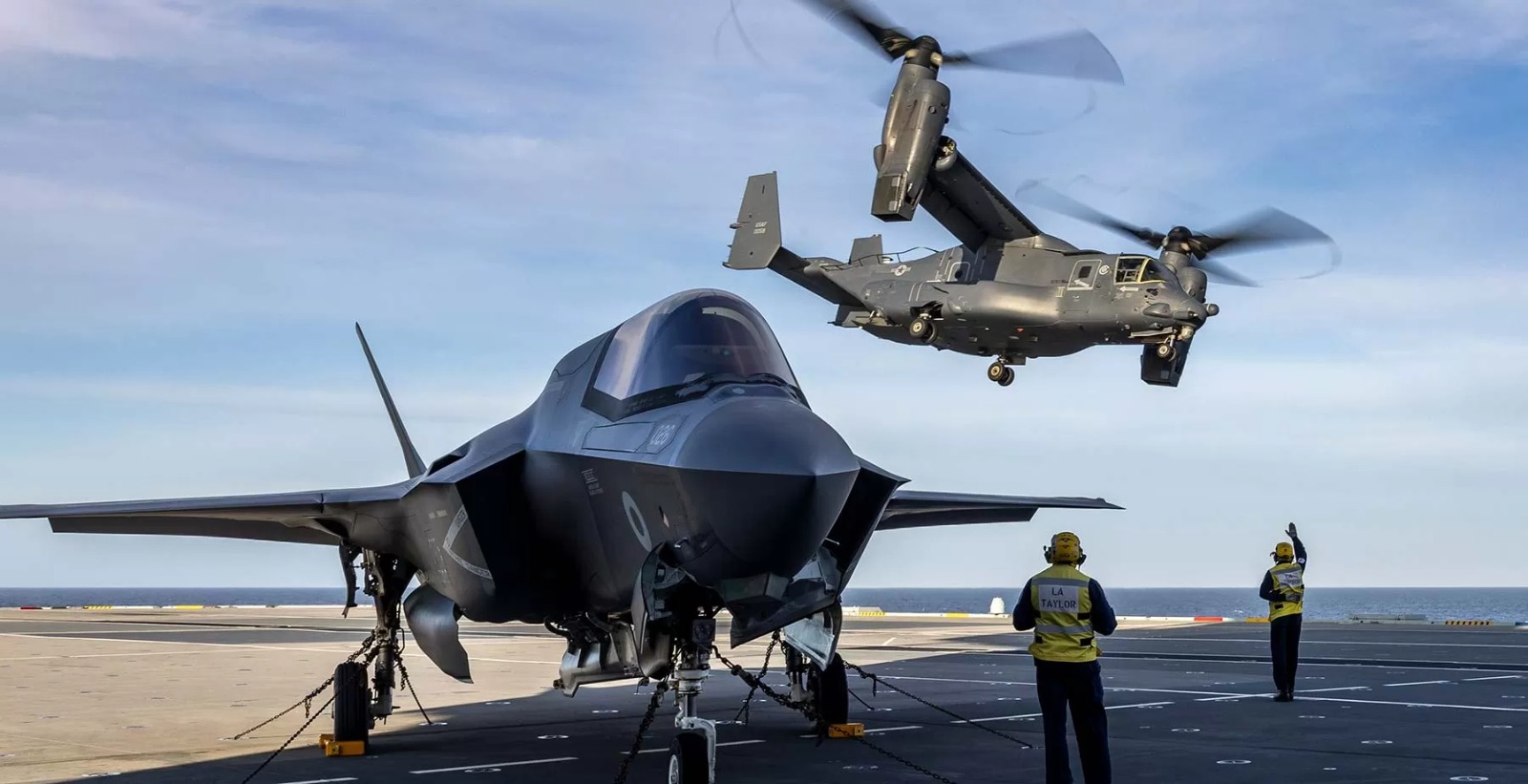The United States Navy has announced the deployment of F-35C Lightning II fighters and CMV-22B Osprey aircraft to Marine Corps Air Station (MCAS) Iwakuni in Japan. This decision, detailed in a press release on July 15, aims to replace the aging squadrons of F/A-18 Super Hornets and C-2A Greyhound transports currently stationed at the base.
The service said that Strike Fighter Squadron (VFA) 147 and Fleet Logistics Multi-Mission Squadron (VRM) 30, Detachment Forward Deployed Naval Forces (FDNF), will be forward deployed to Iwakuni. The squadrons are set to merge with the aircraft of Carrier Air Wing (CVW) 5, based at MCAS Iwakuni.
The F-35C Lightning II jets of VFA 147 will take over from the F/A-18 Hornets of VFA 115, while the CMV-22B Ospreys of VRM 30, Det FDNF, will replace the C-2A Greyhound aircraft previously supporting CVW 5 and Carrier Strike Group (CSG) 5.
Strike Fighter Squadron 115 and its F/A-18s were assigned to Marine Corps Air Station Iwakuni in November 2017. The station presently hosts two Marine Corps squadrons equipped with F-35Bs, short-takeoff, and vertical-landing stealth fighters, alongside two Navy squadrons of Super Hornets integrated with the carrier wing.
This upgrade highlights the Navy’s commitment to maintaining superior air capabilities in the region. This development follows the Department of Defense’s recent announcement to enhance its aerial capabilities at other bases in Japan.
Over the next few years, 36 modern F-15EX aircraft are slated to permanently replace 48 older F-15C/D fighter jets at Kadena Air Base on Okinawa. Additionally, Misawa Air Base in northern Japan is also set to receive 48 F-35A Lightning II aircraft to replace its 36 F-16 Fighting Falcon fighter jets.
As the Chinese military expands its presence in the region, the importance of aerial power in addressing these challenges has led to the implementation of these upgrades.
The service said that CVW 5 is aboard the Nimitz-class aircraft carrier USS Ronald Reagan (CVN 76), which has been forward-deployed to Japan for nearly nine years.
The Ronald Reagan is scheduled to return to the United States for maintenance later this year, and the USS George Washington (CVN 73) will replace it as America’s forward-deployed aircraft carrier in Yokosuka, Japan.
The CVW 5 will continue to serve as the US forward-deployed carrier air wing and will be aboard the George Washington upon its return to Japan.
The George Washington previously served as the Navy’s forward-deployed carrier in Yokosuka from 2008 to 2015. The exact timeline for the new aircraft’s arrival in Japan has not been disclosed.

US Navy Enhances Operational Capabilities With F-35C & CMV-22B Deployments
The US Navy’s decision to upgrade its fighter and transport aircraft is designed to address contemporary threats and enhance operational effectiveness.
The F-35C Lightning II touted as the Navy’s most advanced fighter, plays a crucial role in this effort. According to the Navy, the F-35C is the cornerstone of air superiority, providing a dominant, multi-role, fifth-generation aircraft that bolsters US power projection and deterrence capabilities.
In light of the growing tensions with China in the Western Pacific, this advanced fighter is crucial for carrying out missions that require entering enemy territory.
The Pentagon is developing new strategies to address challenges across the vast distances of the China and Philippine Seas, where the US and allied air bases are vulnerable to potential Chinese attacks.
The plan is to counter these obstacles by sending F-35Cs on long sorties that could span thousands of miles. These missions include making safe returns to carrier decks, navigating enemy air defenses, and using the Joint Standoff Weapon (JSOW), a glide bomb, against enemy targets.
Compared to its F-35B counterpart, the F-35C boasts larger weapons bays and an additional 7,000 pounds of fuel capacity, accommodating heavier munitions, including 2,000-pound JSOW glide bombs.
These attributes enhance the F-35C’s role as the Navy’s premier deep-strike platform, complementing its carrier-based operations with extended operational range and payload capabilities.

In addition to fighter upgrades, the Navy is replacing its C-2A Greyhound transport aircraft with the CMV-22B Osprey. The Osprey offers significant improvements over the Greyhound, including greater operational range, faster cargo loading and unloading, aerial refueling capability, enhanced survivability, and better beyond-line-of-sight communications.
This next-generation aircraft is crucial for maintaining mobility and support for carrier strike groups, ensuring sustained deployment capabilities in high-end combat scenarios.
However, the transition to the CMV-22B has faced delays. An Osprey crash in November in southern Japan, which resulted in the loss of all eight crew members, postponed the replacement and extended the service life of the remaining 15 Navy Greyhounds.
Although the 400 Ospreys in the Navy, Marine Corps, and Air Force have been cleared to fly since March, they will not be fully operational across all their intended missions until mid-2025.
- Contact the author at ashishmichel(at)gmail.com
- Follow EurAsian Times on Google News




